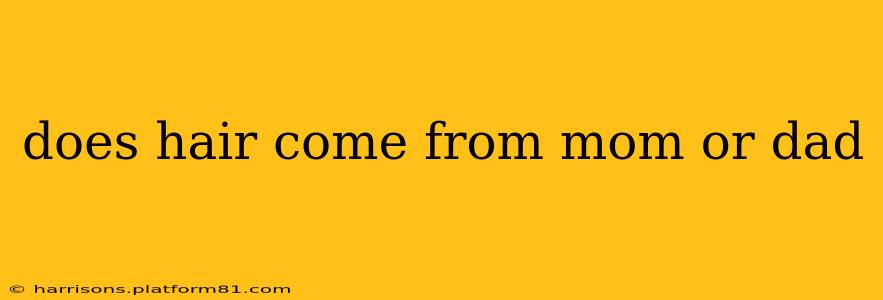The question of whether hair comes from mom or dad is a common one, sparking curiosity about inherited traits. The reality is far more nuanced than simply assigning credit to one parent. Hair characteristics are a complex blend of genetic contributions from both parents, influenced by multiple genes working in concert. Let's delve into the fascinating genetics behind hair color, texture, and even hair loss.
What Genes Determine Hair Color?
Hair color is determined by melanin, a pigment produced by specialized cells called melanocytes. Several genes influence the type and amount of melanin produced, leading to the diverse range of hair colors we see. Some key genes involved include:
-
MC1R: This gene plays a significant role in determining whether you have red, blonde, or brown/black hair. Variations (alleles) in this gene affect the production of eumelanin (brown/black pigment) and pheomelanin (red pigment).
-
TYRP1 and TYR: These genes are also involved in melanin production, influencing the intensity and distribution of pigment in hair.
Both parents contribute alleles for these genes, and the combination received determines your hair color. It's not simply a case of one parent's genes dominating; the interplay of alleles from both parents creates a unique result. This is why siblings can have different hair colors even with the same parents.
How Does Hair Texture Inherit?
Hair texture – straight, wavy, curly, or coily – is another complex trait with a genetic basis. While specific genes haven't been definitively identified as solely responsible for texture, research points to multiple genes working together. These genes influence the shape of the hair follicle, which directly impacts the shape of the hair strand that grows from it.
Similar to hair color, you inherit alleles for these genes from both parents, and the interaction of these alleles determines your final hair texture. This is why children can have different textures from their parents, and siblings can exhibit a range of textures within the same family.
Does Hair Loss Come From Mom or Dad?
Hair loss, or androgenetic alopecia (AGA), is a common condition that affects both men and women. Genetic predisposition plays a significant role in AGA, and this genetic influence is multifactorial, meaning it involves multiple genes. While the exact genes responsible haven't all been identified, research suggests a strong influence from genes on chromosomes X and 20.
It's important to note that while genetics contribute significantly, other factors like hormonal imbalances, stress, and lifestyle choices also influence hair loss. The pattern and severity of hair loss can vary even within families with similar genetic backgrounds.
Does Maternal or Paternal DNA Affect Hair More?
There isn't a single answer to whether maternal or paternal DNA has a greater impact on hair traits. While some genes may be more influential than others, the inheritance pattern is complex and varies from person to person. Both parents contribute equally in terms of number of genes passed on, but the specific alleles inherited determine the ultimate phenotype (observable characteristics).
What Are the Chances of Inheriting a Specific Hair Trait?
The chances of inheriting a specific hair trait depend on the combination of alleles inherited from both parents. Predicting the exact outcome with certainty is not possible, given the intricate genetic interactions at play. Genetic counselors can provide information based on family history and specific gene variations, but it's often a complex probability calculation rather than a definitive prediction.
How Does Hair Texture Differ From Person to Person?
Variations in hair texture arise from the interplay of multiple genes impacting the shape of the hair follicle and the production of proteins like keratin. Environmental factors also play a role, including nutrition, hormonal changes, and styling practices. These interactions create the incredible diversity in hair texture observed across populations.
In conclusion, hair traits are not solely determined by one parent. Instead, it's a captivating interplay of genetic contributions from both mother and father, creating the unique and diverse characteristics we see in human hair. Understanding the underlying genetics provides a deeper appreciation for the complexities of inheritance and the beautiful diversity of human hair.
